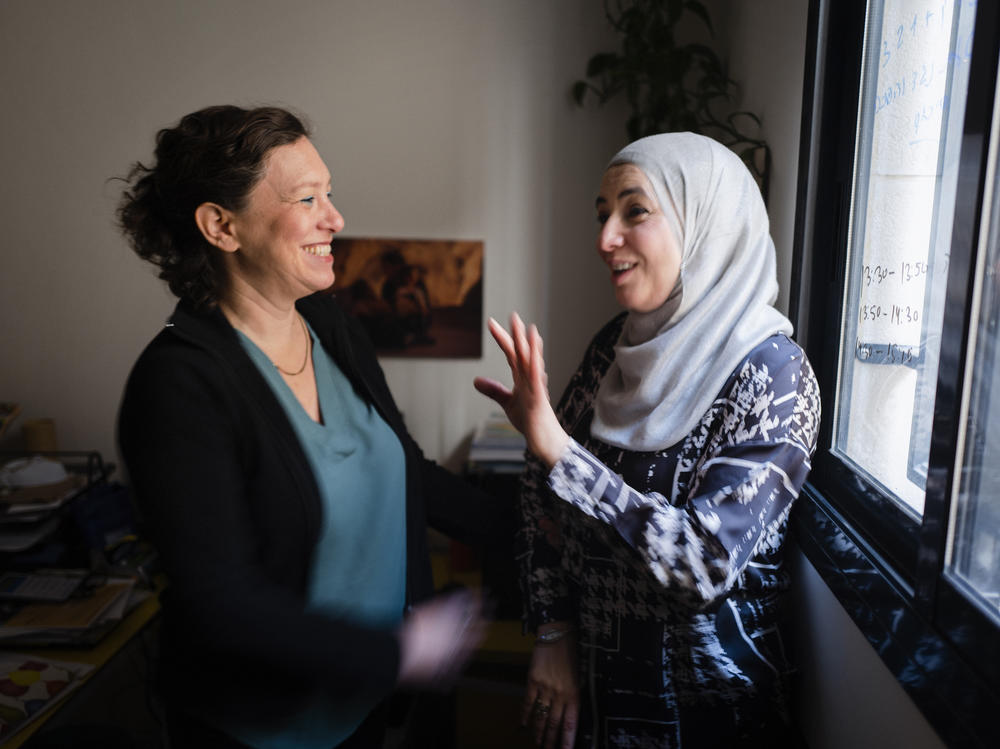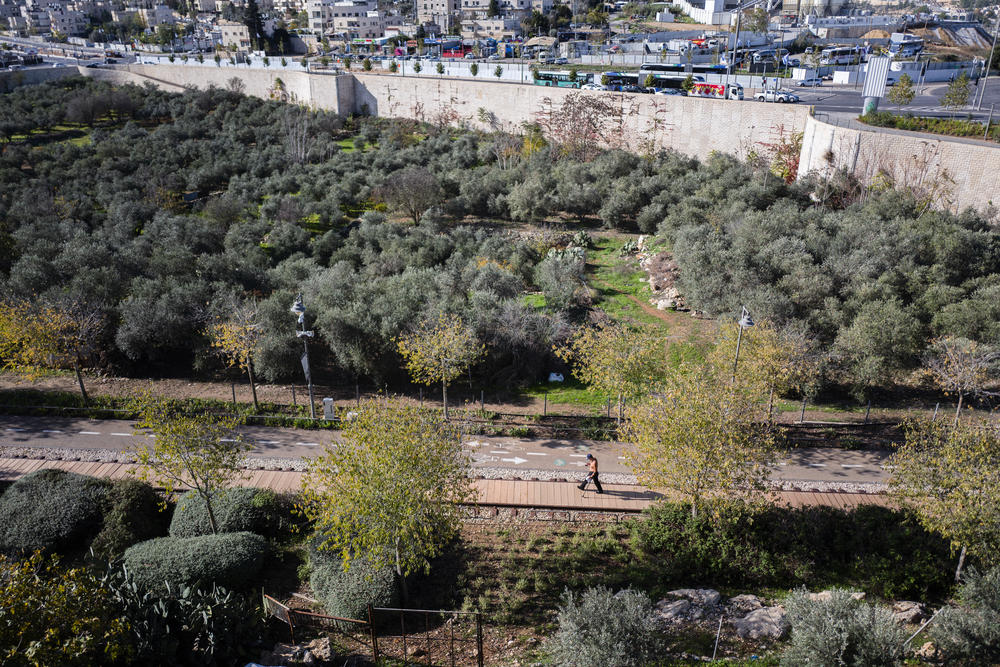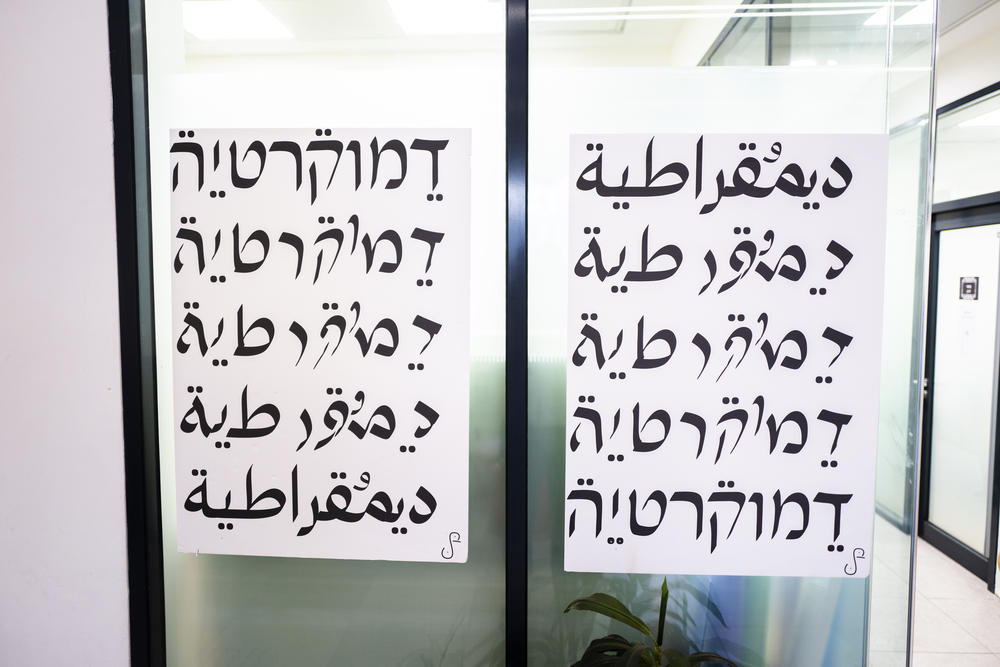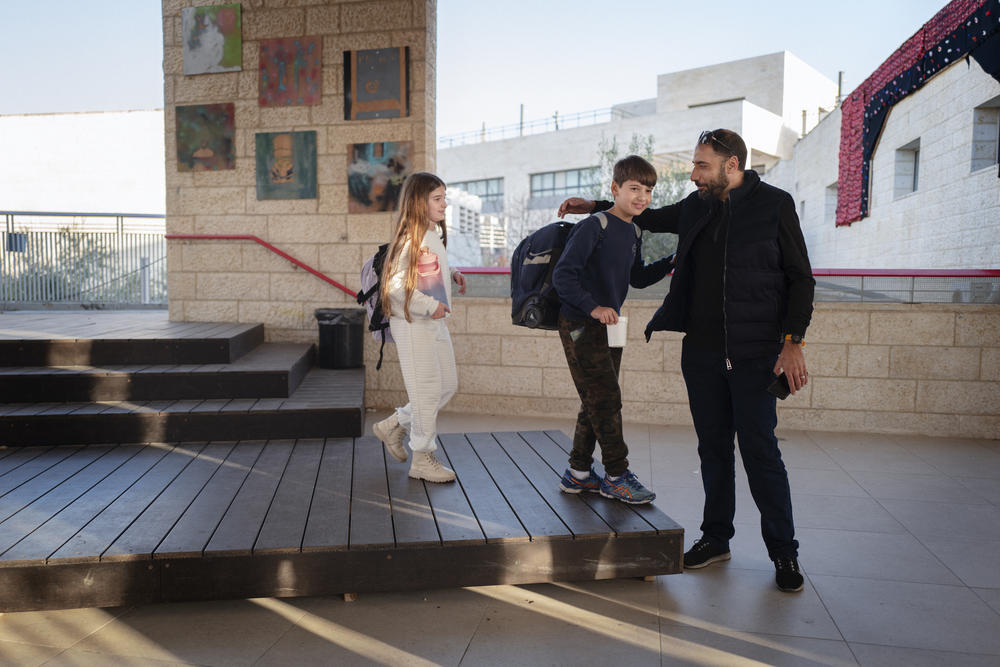Section Branding
Header Content
A school in Jerusalem brings Arab and Jewish kids together to boost understanding
Primary Content
JERUSALEM — When the bell rings at Jerusalem's Hand in Hand school, you hear something that's not common in Israel: the sound of young people's voices rising together in laughter and conversation in both Hebrew and Arabic.
Israeli society is largely segregated. There is no law officially mandating segregation, but the separation of Jews and Arabs — who make up 20% of Israel's population — usually begins at a young age, with separate school systems.
The separation begins at kindergarten, when Jewish and Arab children are sent to different schools and experience completely separate education "tracks" or systems.
"Arabs go to Arab schools in their neighborhoods and Jews go to Jewish schools in the areas where they live," says Nour Younis, events manager for Hand in Hand.
Younis, who is Palestinian, says Arabic language and Arab culture are also mostly absent from the public sphere in Israel, so Arabs tend to stay in their own circles.
There are shared spaces like hospitals and banks, but Younis says it doesn't mean people have real connections. She made her first Jewish acquaintance at age 19, in college.
"We grow up with stereotypes about the other," she says. "You know, 'This is the enemy, this is that, we don't know anything about each other.' And on the first confrontation with each other, sometimes we don't even know how to talk to each other when you get to a certain age."
Some Israelis believe the separation leads to, and perpetuates, division. And ending decades of conflict will take increased knowledge and understanding between Jews and Arabs, through mixing.
That's the concept behind Hand in Hand, founded in 1998 by a group of parents who wanted their children to grow up differently. What began as two kindergarten classes in Jerusalem and Galilee has now become six campuses nationwide, with some 2,000 students.
The school's eventual goal is to create a fifth track of education within the Israeli school system. Today there are four options: Arab schools and three Jewish tracks — secular, religious and ultra-Orthodox.
Hand in Hand is part of the public system, but is also partially funded by private donations and student tuition to support the school's multicultural curriculum, which includes bilingual classes and the presence of a community organizer who works closely with parents.
The students at Hand in Hand campuses are around 60% Arab and 40% Jewish. There is a waiting list of Arab children who would like to attend.
"Students are coming here every day to get to know each other from a very young age," says Efrat Meyer, the Jerusalem school's principal, who is Jewish.
Meyer says Hand in Hand creates a different reality.
"In the beginning," she says, "they learn very basic knowledge about each other. And as they grow up, it becomes deeper understanding of the different lives that we're living here, the different narratives that we hold."
Among Hand in Hand's graduates are lawyers and peace advocates striving for justice and integration across Israel.
"We practice empathy and understanding and we practice sharing our feelings and our identities," Meyer says. "Not separately, but together."
The principal says it's been difficult since the Oct. 7 Hamas-led attacks, which Israeli says killed 1,200 people, and the ongoing war that Gaza health officials say has killed more than 25,000 Palestinians. But Meyer says teachers and students have been practicing for so many years that they've developed different muscles than the rest of Israeli society.
Hand in Hand is one of the only bilingual Arabic-Hebrew schools in Israel. School officials say 90% of Israeli Arabs speak Hebrew, but only around 6% of Israeli Jews speak Arabic.
Students can study Arabic in middle and high school in Israel's Jewish schools, but Younis says it is not mandatory. And even if they do study it, the Arabic taught in Israel is formal, not the spoken Arabic of Palestinians, which she calls "like a completely different language."
Classes at Hand in Hand are taught in both languages by two native speakers in each classroom. The teachers do not duplicate lessons, but complement each other, say the administrators.
Engie Wattad, the Palestinian vice principal at Hand in Hand, and Meyer are longtime colleagues and friends. Since Oct. 7, Wattad says, this school has become a rare oasis of freedom for Palestinians who say they can be harassed or worse for expressing their anguish over the war.
Israel is largely focused on the plight of its hostages, soldiers and the pain of the Oct. 7 attack. And Israeli media are not showing the images of destruction and death in Gaza that much of the world is seeing.
"For our students, this is a safe place, a safe environment," says Wattad. "They feel here that they have freedom of speech. That they're not afraid to say how they feel. They're not afraid to share their grief. Because they've been raised on these values of respecting one another, and being able to hold the grief of the other."
Still, Hand In Hand remains on high alert. It has been targeted in the past. In 2014, three Jewish men were convicted of an arson attack on the school. They also spray-painted racist messages on school walls, such as "There is no coexistence with cancer" and "Death to the Arabs."
Daniel De Shalit, a civics teacher at Hand in Hand, says dual narrative history is taught here. "That means learning about conflicts not just from one point of view, but from multiple ones," he says. "To see how the same events can be shaped into different stories, and how each side could be absolutely sure they are the just one."
The experience of teaching here has transformed him, he says.
"It changed my entire identity," he says. "Because when you live and work in this way, it somehow changes who you are. It makes you more human in the way that you can see human beings, regardless of their nationality, and have empathy with them no matter what side of the conflict they are on."
Chaim Mayer used to teach high school elsewhere, but wanted to teach younger kids in the hope of being able to shape them. He says with a laugh that his first graders "don't hate each other, they speak nicely to each other. They are not tainted yet."
By third grade, it's often too late, Mayer believes.
"It's not easy," he says of his teaching job. "But it's the best and the only possibility to make a change in the future. Maybe it's a drop in the bucket what we're doing, but we still have to try."
Principal Meyer says education is about hope.
"We're strengthening the shared values, the possibility for a different life here," she says. "And this is something that didn't change. We all want to see a different reality here. I want to see an equal society for me and for Engie [Wattad], together."
At pick-up time, Palestinian Morad Muna comes with his wife Raneen Muna to fetch their twin fifth-graders. The 43-year-old father remembers the fear around the first and second intifadas or Palestinian uprisings when he was growing up. He says today is worse.
"Never have we been in such a situation," he says. "Never we have [been] afraid like we [are] afraid now. Never we see this demolish that [is] happening in Gaza. Never we see this number of victims — children — I mean, it's totally unbelievable. And we don't know where we are going."
Raneen Muna believes the school is the one safe place right now for their kids, as the war is widening the gulf in Israeli society between Arabs and Jews.
Naama Hochstein, also at pickup, says her three children have a different outlook than kids who attend Jewish schools.
"They are able to see that there are maybe different points of view," she says. "And the fact that they grow up with Arabic from a very young age — both the language and culture — it just makes it a beautiful part of their identity and existence, instead of something they're always intimidated by."
Hochstein believes Israel would be a different place if there were more schools like Hand in Hand.
Copyright 2024 NPR. To see more, visit https://www.npr.org.





